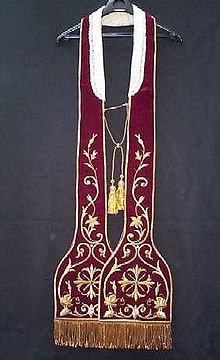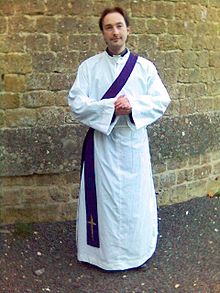Stole (liturgical clothing)


The stole is a liturgical garment that is worn as an official badge by Catholic and Eastern Church, sometimes also by Protestant clergy of different denominations .
Shape and way of carrying
The stole is a narrow strip of fabric about 2.50 m long. As an official badge, it is reserved for the holders of the relevant church office and is required for worship. In the Holy Mass , the stole usually follows the liturgical canon of colors among Catholics . Outside of mass, the white stole is usually used, the violet stole for the sacrament of penance and the purple or black stole at the funeral ceremony .
The stole is worn differently: Catholic deacons wear it as a sash over the left shoulder, while priests and bishops wear it over both shoulders. At Holy Mass, the stole is usually worn under the dalmatic or the chasuble ( chasuble ) over the alb and fastened with the cingulum , during the solemn liturgy of the hours , at processions , funerals and Eucharistic devotions over the alb and under the cope . When celebrating the Word of God and giving baptism and marriage outside of Holy Mass, the leader of the service wears a choir shirt and a stole over it. When giving sacraments outside the church, such as anointing the sick , confession or communion at the bedside, the priest can also put the stole on over civilian clothes.
Before Vatican II , the Roman Missal stipulated that the priest should cross the stole over the chest, while the bishop should let the ends hang down. After the council it was determined that the bishop and the priest alike would let the ends of the stole hang down. Outside of the mass, the stole was not crossed beforehand if the cingulum was missing for attachment. Priests who celebrate Mass according to the 1962 missal continue to wear the stole crossed. Eastern church deacons usually wear their (longer) stoles hanging freely over the left shoulder, but for practical reasons they loop them around the chest and back in an X-shape when serving at the altar. The Eastern Church priest stole is placed around the neck like in the Western Church, both ends hang uncrossed in front of the wearer's chest, often linked together or as a closed length of fabric with a neck opening.
The stole is often richly decorated with ornaments and crosses.
Sometimes it is worn today by Roman Catholic priests over the chasuble to make the official badge visible to the faithful, which the liturgical rules do not explicitly provide.
In Protestant churches the stole - if it is used - is simply worn over the gown or alb of the clergy.
origin
The use of the stole (from the Gaulish for robe ; original name orarium ; in the Greek rite Orarion for the deacon or Epitrachelion for the priest / archpriest) is attested early in the Christian churches.
The Synod of Laodicea (372) already mentions the Orarion, which lecturers , psalm singers and subdeacons were forbidden to wear there. In Gaul (see also Gallican rite ) the episcopal stole is attested in the 6th century, the Synod of Braga (561) already knows the different ways of wearing it.
In Rome, the episcopal stole was not worn until the 8th and 9th centuries. Century on. Previously, all degrees of ordination (deacon, priest and bishop) wore the stole in the same way. In the 9th century the general name stole developed.
The sloping stole of the deacon developed in the High Middle Ages from the custom that on days of penance the deacon wrapped the chasuble as a planeta plicata around his body like a sash in Holy Mass from the Gospel onwards. Since it was difficult with modern chasubles to fold them in this way, they could be replaced by a wide band, which was called stola latior ("wider stole") because of its similarity to a stole , but was not a stole. However, these forms of carrying are no longer used in the Roman rite, which was renewed by the Second Vatican Council .
Symbolically, the priest's stole is the yoke of Christ ( iugum christi ) that he wants to wear. The handing over of the stole is one of the rites of deacon ordination and priestly ordination .
While in the Eastern Churches the stole ( orarion ) is sometimes worn by the lecturer , in the Roman Catholic Church it is only worn by the deacon, priest or bishop. The Carthusian nuns are an exception : Here, when the nun is consecrated as a virgin, the bishop not only receives the traditional insignia but also the stole that the Hebdomadarin is allowed to wear when reciting the gospel during the vigil .
Stole in Protestantism
During the Reformation period, chasuble vestments were often in use in the Lutheran churches. The chasubles are counted among the Adiaphora . They therefore are not considered as writing inkonform, but not as necessary for salvation. Martin Luther himself wore chasubles to the celebration of the Lord's Supper, only the black skirt of the theological university professors at the time for sermons. The chasuble was not made until 1811 when the black gown was introduced by a cabinet order from King Friedrich Wilhelm III. Filed in Prussia for pastors in Protestant churches, judges, rabbis and royal officials. From then on it developed together with the Beffchen into the regular official costume . Therefore, the black gown is unknown in many Lutheran churches outside Germany as the official costume of the clergy. Even in Germany it did not establish itself across the board.
Today, the stole is being rediscovered, especially in the Lutheran churches, as part of liturgical clothing. Because while the black gown mainly emphasizes the teaching character, the stole emphasizes the aspect of celebration. Through its color it also emphasizes the color symbolism of the church year ( liturgical colors ) and breaks through the aura of the black gown, which is sometimes perceived as rigid and dreary.
In most member churches of the EKD, the stole can be worn with or without a little bucket with a gown or alb. In the Independent Evangelical Lutheran Church (SELK), wearing a small beef and stole is not covered by the church ordinances over the liturgical vestments. In the SELK, on the other hand, the stole can either be worn over the alb , the choir shirt , the gown , over or under the chasuble .
The correct style of dress is also controversial among proponents of the stole. There are groups, for example, who reject wearing the stole together with beffchen or wearing the stole with a black gown, because, in their opinion, it leads to a mixture of Protestant official costume and liturgical garment. The question of whether the color of the stole must match the church year or whether, for example, it is also possible to generally wear a colorful “rainbow stole” is controversial and a question of the applicable church law .
Critics often object to the stole that it does not fit the teaching of the priesthood of all baptized people: According to 1. Peter 2.9 EU , all believers are priests , so that there is no need for a priest in worship. The Reformed side also argues that wearing the stole is an attempt to tie in with the priesthood of the Roman Catholic Church. On the other hand, outside Germany, especially in the USA, Reformed, Baptist and Pentecostal preachers as well as all other participants in the service (lecturers, musicians, choir singers, etc.) wear the stole as a sign of commissioning by the congregation.
literature
- Joseph Braun : The liturgical garb in Occident and Orient: According to origin and development, use and symbolism. 2nd, improved edition. Herder, Freiburg (Breisgau) 1924 (reprographic reprint. Verlag Nova and Vetera, Bonn 2005, ISBN 3-936741-07-7 ).
Web links
Individual evidence
- ↑ AEM No. 298ff.
- ↑ NPNF2-14. The Seven Ecumenical Councils - Christian Classics Ethereal Library. Retrieved February 22, 2017 .
- ↑ NPNF2-14. The Seven Ecumenical Councils - Christian Classics Ethereal Library. Retrieved February 22, 2017 .
- ↑ Joseph Braun: The liturgical garb in the Occident and Orient: According to origin and development, use and symbolism. 2nd, improved edition. Herder, Freiburg (Breisgau) 1924 (Reprographischer Reprint. Verlag Nova and Vetera, Bonn 2005), pp. 103, 138.
- ↑ Joseph Braun: The liturgical garb in the Occident and Orient: According to origin and development, use and symbolism. 2nd, improved edition. Herder, Freiburg (Breisgau) 1924 (Reprographischer Reprint. Verlag Nova and Vetera, Bonn 2005), pp. 139, 142f.
- ↑ Winfried Haunerland (Ed.): Manifestatio ecclesiae. Studies on pontifical and episcopal liturgy (= studies on pastoral liturgy. Vol. 17). Pustet, Regensburg 2004, ISBN 3-7917-1885-1 .

